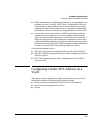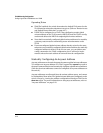
4-17
IPv6 Addressing Configuration
Neighbor Discovery (ND)
Neighbor Discovery (ND)
Neighbor Discovery (ND) is the IPv6 equivalent of the IPv4 ARP for layer 2
address resolution, and uses IPv6 ICMP messages to do the following:
■ Determine the link-layer address of neighbors on the same VLAN inter-
face.
■ Verify that a neighbor is reachable.
■ Track neighbor (local) routers.
Neighbor Discovery enables functions such as the following:
■ router and neighbor solicitation and discovery
■ detecting address changes for devices on a VLAN
■ identifying a replacement for a router or router path that has become
unavailable
■ duplicate address detection (DAD)
■ router advertisement processing
■ neighbor reachability
■ autoconfiguration of unicast addresses
■ resolution of destination addresses
■ changes to link-layer addresses
■ anycast address operation
An instance of Neighbor Discovery is triggered on a device when a new
(tentative) or changed IPv6 address is detected. (This includes stateless,
stateful, and static address configuration.) ND operates in a per-VLAN scope;
that is, within the VLAN on which the the device running the ND instance is a
member. Neighbor discovery actually occurs when there is communication
between devices on a VLAN. That is, a device needing to determine the link-
layer address of another device on the VLAN initiates a (multicast) neighbor
solicitation message (containing a solicited-node multicast address that corre-
sponds to the IPv6 address of the destination device) on the VLAN. When the
destination device receives the neighbor solicitation, it responds with a
neighbor advertisement message identifying its link-layer address. When the
initiating device receives this advertisement, the two devices are ready to
exchange traffic on the VLAN interface. Also, when an IPv6 interface becomes
operational, it transmits a router solicitation on the interface and listens for a
router advertisement.


















